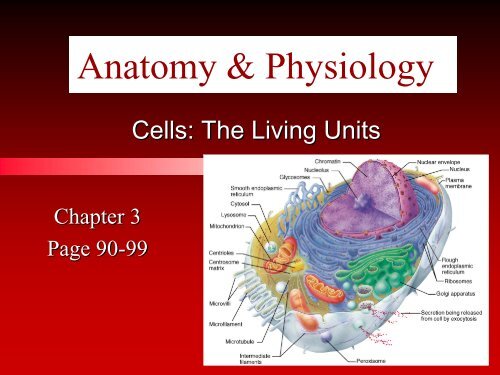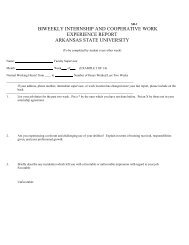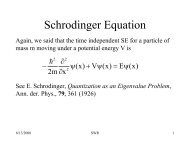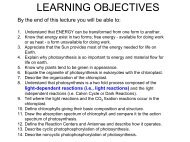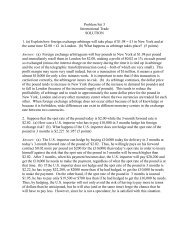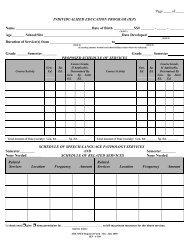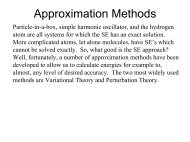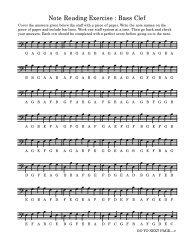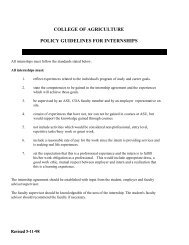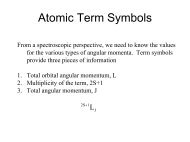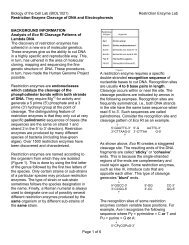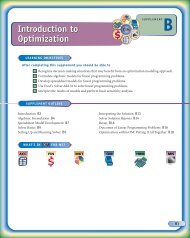Anatomy & Physiology - Arkansas State University
Anatomy & Physiology - Arkansas State University
Anatomy & Physiology - Arkansas State University
You also want an ePaper? Increase the reach of your titles
YUMPU automatically turns print PDFs into web optimized ePapers that Google loves.
<strong>Anatomy</strong> & <strong>Physiology</strong>Cells: The Living UnitsChapter 3Page 90-9999
Sie haben die Wahl!Touchlock-Tastaturen sind als Kompaktsysteme für den Einsatz mit Switch2- und Net2-Systemen erhältlich. Die rückbeleuchtete und dieEdelstahl-Tastatur der Serie K sind nach IPX7 für externe Verwendung geeignet. Beide Typen sind in drei Größen erhältlich: 38 mm, 50mm und 75 mm breit. Die rückbeleuchtete Tastatur ideal für lichtarme Installationen geeignet und wird mit einem weißen und einemschwarzen Rahmen geliefert. Eine TOUCHLOCK-Edelstahltastatur bietet eine robuste Metallbauweise mit einem Satin-Chrompolitur.Alle unsere TOUCHLOCK-Tastaturen sind durch unsere 5-Jahre-Garantie gesichert.K38K50K75K38K50K75TOUCHLOCK Serie K(Rahmen in Schwarz und Weiß mitgeliefert)TOUCHLOCK-Edelstahltastaturen der Serie K(Edelstahl- / Satin-Chrompolitur)Hervorragende Tastaturen - neue NiedrigstpreiseWir haben die Preise unserer TOUCHLOCK-Tastaturen drastisch gesenkt. Die zuverlässigen und benutzerfreundlichen TOUCHLOCK-Produkte sind jetzt zudem auch äußerst preisgünstig. Aufgrund der starken Nachfrage konnten wir die Produktion steigern und aufdiese Weise die Kosten pro Einheit senken. Dies ist kein Sonderangebot, diese Preise gelten für das gesamte Jahr 2007.Art.-Nr. Beschreibung Rückbeleuchtet Preis (2006) Preis (2007) Einsparung331-210-D TOUCHLOCK K38 compact Tastatur Ja €130.05 €91.80 29%351-210-D TOUCHLOCK K50 compact Tastatur Ja €130.05 €91.80 29%371-210-D TOUCHLOCK K75 compact Tastatur Ja €130.05 €91.80 29%371-220-D TOUCHLOCK K75 compact Tastatur mit Schraubanschluss Ja €130.05 €91.80 29%332-210-D TOUCHLOCK K38 compact Edelstahl-Tastatur Nein €160.65 €137.70 14%352-210-D TOUCHLOCK K50 compact Edelstahl-Tastatur Nein €160.65 €137.70 14%372-210-D TOUCHLOCK K75 compact Edelstahl-Tastatur Nein €160.65 €137.70 14%372-220-D TOUCHLOCK K75 compact Edel-Tastatur Schraubanschluss Nein €160.65 €137.70 14%331-110-D TOUCHLOCK K38 Tastatur Ja €91.80 €61.20 33%351-110-D TOUCHLOCK K50 Tastatur Ja €91.80 €61.20 33%371-110-D TOUCHLOCK K75 Tastatur Ja €91.80 €61.20 33%371-120-D TOUCHLOCK K75 Tastatur mit Schraubanschluss Ja €91.80 €61.20 33%332-110-D TOUCHLOCK K38 Edelstahl-Tastatur Nein €122.40 €107.10 12.5%352-110-D TOUCHLOCK K50 Edelstahl-Tastatur Nein €122.40 €107.10 12.5%372-110-D TOUCHLOCK K75 Edelstahl-Tastatur Nein €122.40 €107.10 12.5%372-120-D TOUCHLOCK K75 Edelstahl-Tastatur mit Schraubanschluss Nein €122.40 €107.10 12.5%Kontaktieren Sie uns noch heute!Wenn Sie nähere Informationen zur Produktfamilie der hervorragenden TOUCHLOCK-Tastaturen der Serie Kwünschen, kontaktieren Sie uns noch heute.TOUCHLOCK. Verbannen Sie Ihre Schlüssel — für immer!Telefon: 03 086 399 710E-Mail: verkauf@paxton.co.uk
Sizes of Human CellsSCALE: 1000 µm = 1 mmred blood cellhuman egg cellwhite blood cellSmooth muscle cell
Cell Type and Functions: ExamplesNerve cell – transmits impulsesEpithelial cells – form protective layersMuscle cells - contraction
“Typical” Human Cell
Extracellular Materials• Body Fluids (interstitial fluid; blood plasma,cerebrospinal fluid)• FYI: Interstitial fluid is found in the spaces between tissue cells, cconstituting on average about 16% of human body or about 11 liters (2.42gallons) of interstitial fluid in an adult providing the cells of the body withnutrients and a means of waste removal.• Cellular Secretions (gastric fluids, saliva, mucus)• Extracellular Matrix (organized mesh of proteins andpolysaccharides secreted by cells into the extracellularspace)
The Cell or Plasma Membrane
The Cell or Plasma Membrane
The Cell or Plasma Membrane
Cytoplasm – material between plasmamembrane and the nucleusThree major elements:• Cytosol – largely water with dissolved protein,salts, sugars, and other solutes• Cytoplasmic organelles – metabolic machineryof the cell• Inclusions – chemical substances such asglycosomes, , glycogen granules, and pigmentProtoplasm – living matter – cytoplasm and nucleus
Cytoplasmic Organelles - specialized cellularcompartments with specific functionsSome (membranous) are bounded by amembrane similar to the cell membraneMitochondria, Peroxisomes, Lysosomes,Endoplasmic Reticulum, Nucleus, GolgiBodies, VesiclesOthers (nonmembranous) lack a membraneCytoskeleton, Centrioles, and Ribosomes
The Cell Cycle
InterphaseG 0 – no cell divisionG 1 – gap1, metabolismand growthS Phase – DNA synthesisG 2 – gap 2, growth andpreparation for divisionCell CycleMitosis (Nucleardivision – Karyokinesis)Cytokinesis(Cytoplasmic Division)
DNA Replication•Each free nucleotide strand isa template for building a newcomplementary strand(semiconservative replication)•DNA + Protein = chromatin(uncondensed) or chromosomes(condensed)•Chromatin or chromosomesconsist of about 40% DNA and60% protein
DNA Fingerprinting or Profiling•DNA is extracted from cells and cut intofragments of various sizes by restriction enzymes.•Gel electrophoresis separates the fragments by size.•Separated fragments are transferred to anylon membrane (Southern blot).•Some of the sequences are labeled withradioactive substances (probes).•X-ray film is exposed by the radioactivityof the labeled sequences.•The autoradiogramshows the patternof a DNA profile.http://www.pbs.org/wgbh/nova/sheppard/labwave.html
Interphase – G 1 , S, G 2
Unduplicated & Duplicated Chromosomes• During interphase chromosomes go from beingunduplicated to duplicated.• Each chromosomes goes from possessing one DNAmolecule to possessing two DNA molecule.• Each chromosome goes from possessing one chromatid topossessing two chromatids.• For animation of cell cycle visit: http://highered.mcgraw-hill.com/sites/0072437316/student_view0/chapter11
Mitosis followed by Cytokinesis
Mitosis – P, M, A, TChromosomes become visible as the chromatin coils andforms rod-shaped strands. Each chromosome now consistsof two identical strands called sister chromatids attachedat the centromere.The nuclear membrane breaks down and disappears.The centrioles move to opposite poles of the cell and themitotic spindle forms.Microtubules attach to the kinetochores (part of centromere)
Mitosis - prophase
Mitosis - metaphaseChromosomes (sister chromatids) are moved to theequator (metaphase plate) of the spindle.
Mitosis - anaphaseSister chromatids separate (now called chromosomes) and aremoved towards opposite poles of the spindle by the spindlefibers (microtubules).
Mitosis - telophaseThe chromosomes reach the poles. A nuclear membraneforms around the chromosomes, nucleoli reform, and thespindle disappears. Two identical daughter nuclei are formed.
Mitosis – telophase; ; Cytokinesis
Fertilization and the Fate of Cells
Cell Differentiation
Cancer: cell divison gone wrong
Cell Tissue Culture; Tissue/Organ RepairIN THE NEWSImplanted Tissue Repairs Damaged BladdersNational Public Radio - April 4, 2006 · Researchers announce they'vegrown bladder tissue in a laboratory and used it to successfully repairdamaged bladders. The Wake Forest <strong>University</strong> researchers publishedtheir results in The Lancet. Link available at:http://www.npr.org/templates/story/story.php?storyId=5321689-------------------------------------------------------------------------Doctors grow organs from patients' own cellsWednesday, April 5, 2006HADDAM NECK, Connecticut (CNN) -- Seven living with bladders from newprocess. Link available at:http://edition.cnn.com/2006/HEALTH/conditions/04/03/engineered.organs/index.html
Lab Grown Organs – Human Bladder• Scientists RebuildBladder in 7 PatientsBOSTON, Apr. 3,2006• See link at:http://www.cbsnews.com/stories/2006/04/03/ap/health/mainD8GOQ9C83.shtml


